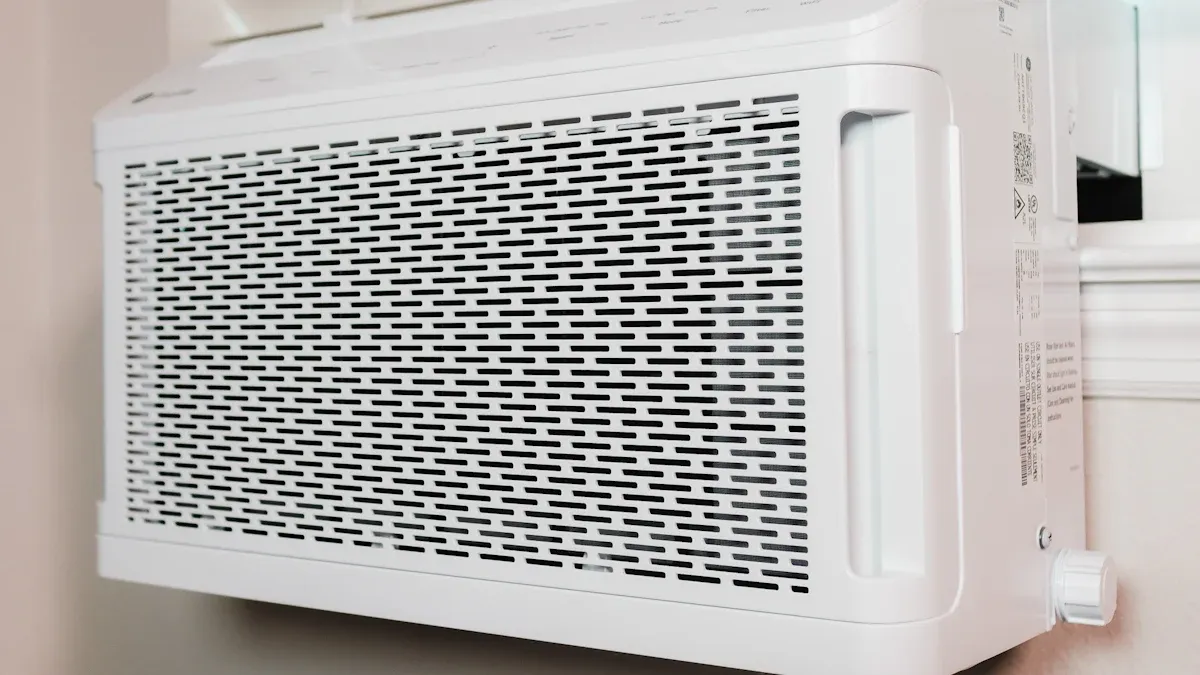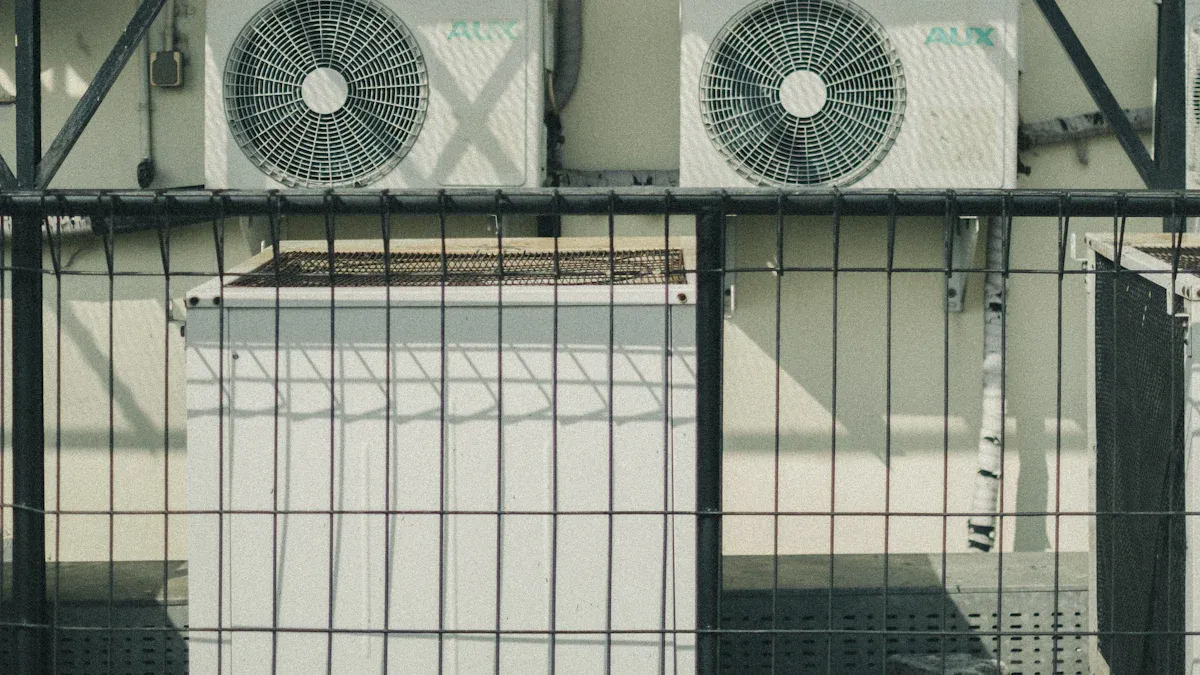How Eco-Friendly Copper-Aluminum Fin Heat Exchangers Reduce Carbon Footprint in Refrigeration

I’ve seen how refrigeration systems impact the environment. Eco-Friendly Copper-Aluminum Fin Heat Exchangers offer a solution. These systems reduce energy use and greenhouse gas emissions. Companies like Ningbo Senjun New Materials Co., Ltd. lead this innovation. Their Copper Fin Heat Exchanger designs improve efficiency while supporting sustainable cooling for a greener future.
Key Takeaways
- Copper-Aluminum Fin Heat Exchangers save energy and cut pollution.
- They use strong materials like copper and aluminum to work better.
- This stops leaks and helps protect the environment.
- These exchangers can be recycled easily, reducing trash and helping nature.
Environmental Challenges in Traditional Refrigeration
High energy consumption and its impact on carbon emissions
I’ve noticed that traditional refrigeration systems consume a significant amount of energy. This high energy demand directly contributes to carbon emissions. For example, many refrigeration units rely on electricity generated from fossil fuels. As a result, they release large amounts of CO2 into the atmosphere. This creates a ripple effect, accelerating global warming. Reducing energy consumption in refrigeration systems is critical for lowering these emissions. Eco-Friendly Copper-Aluminum Fin Heat Exchangers play a vital role in addressing this issue by improving energy efficiency.
The environmental cost of refrigerant leakage
Refrigerant leakage is another major challenge. I’ve learned that even small leaks can have a massive environmental impact. For instance:
- One kilogram of R410a refrigerant has a greenhouse effect equivalent to 2 tons of CO2.
- The average leak rate of HVAC systems in commercial buildings is 35%.
These numbers highlight the urgent need to minimize refrigerant leakage. Advanced materials like copper and aluminum, known for their durability and corrosion resistance, help reduce this risk. By preventing leaks, we can significantly cut down on greenhouse gas emissions.
The need for sustainable alternatives in cooling systems
The world is moving toward sustainable solutions, and refrigeration systems must follow suit. Studies like the India Cooling Action Plan (ICAP) emphasize this need. ICAP aims to reduce refrigerant use by 25-30% and cooling energy demand by 25-40%. It also targets a 20-25% reduction in overall cooling demand. These goals underline the importance of adopting technologies like Eco-Friendly Copper-Aluminum Fin Heat Exchangers. Such innovations not only reduce environmental impact but also align with global sustainability efforts.
Eco-Friendly Properties of Copper and Aluminum

Superior thermal conductivity for energy efficiency
I’ve always been impressed by how copper and aluminum excel in thermal conductivity. Copper, with a thermal conductivity of 401 W/m·K, is nearly twice as efficient as aluminum, which has a conductivity of 205 W/m·K. This means copper transfers heat more effectively, making it ideal for heat exchangers. Aluminum, while slightly less conductive, still performs exceptionally well and offers a lightweight alternative. Together, these metals enhance the energy efficiency of refrigeration systems. By using small-diameter copper tubes, manufacturers can further improve system performance. This reduces resource use and minimizes environmental impact. These properties make Eco-Friendly Copper-Aluminum Fin Heat Exchangers a game-changer in sustainable cooling.
Durability and corrosion resistance for reduced refrigerant leakage
Durability is another standout feature of copper and aluminum. I’ve noticed that their corrosion resistance significantly reduces the risk of refrigerant leakage. This is crucial because refrigerant leaks can have a devastating impact on the environment. For example, advanced designs using these materials have reduced copper use by 40% while improving efficiency. This not only decreases electricity demand but also ensures long-lasting performance. By preventing leaks, these metals help refrigeration systems operate more reliably, cutting down on greenhouse gas emissions.
Recyclability and reduced material waste
Recyclability is where copper and aluminum truly shine. Research shows that copper systems ensure high levels of material circularity, reducing environmental impact. Aluminum recycling rates have increased from 24% to 26% in recent years, while copper maintains a steady recycling rate of 34%. These metals contribute to a circular economy by minimizing waste and promoting reuse. Using aluminum fin stock also helps companies lower their carbon footprint. By adopting these eco-friendly materials, industries can meet regulatory requirements and align with consumer preferences for greener products.
Innovations in Eco-Friendly Copper-Aluminum Fin Heat Exchangers

Advanced design for optimized heat transfer
I’ve seen how advanced designs in Eco-Friendly Copper-Aluminum Fin Heat Exchangers improve heat transfer. These innovations rely on cutting-edge techniques like Computational Fluid Dynamics (CFD) and Finite Element Analysis (FEA). CFD helps visualize temperature and pressure distributions, while FEA assesses structural integrity. Tools like HTRI Xist Software simulate heat exchanger performance, predicting heat transfer rates and pressure drops.
| Technique | Benefits |
|---|---|
| Computational Fluid Dynamics | - Reduced development time and costs - Enhanced understanding of flow patterns and thermal behavior |
| Finite Element Analysis | - Simulates stresses and deformations - Optimizes material usage and thermal performance |
| HTRI Xist Software | - Predicts key metrics like heat transfer rates - Based on experimental data correlations |
These tools allow manufacturers to test multiple designs quickly, reducing costs and improving efficiency. I’ve noticed that such innovations not only optimize heat transfer but also enhance the overall reliability of refrigeration systems.
Reduced refrigerant usage through efficient performance
Efficient performance is another key benefit of these heat exchangers. I’ve learned that new designs can reduce refrigerant usage by up to 45%. This is achieved by modifying copper tube diameters and using advanced software for performance simulation. These changes also improve energy efficiency by up to 6%.
- Smaller copper tubes enhance heat transfer while using less material.
- Advanced designs decrease electricity demand, further lowering environmental impact.
- Efficient systems require less refrigerant, reducing greenhouse gas emissions.
These improvements make Eco-Friendly Copper-Aluminum Fin Heat Exchangers a sustainable choice for refrigeration systems.
Lightweight aluminum fins for lower energy requirements in transportation and installation
Lightweight aluminum fins offer significant advantages. I’ve noticed how their reduced weight simplifies handling and installation. This not only speeds up project timelines but also lowers transportation energy requirements.
- Lighter materials improve fuel economy in vehicles, reducing energy consumption.
- Enhanced airflow from lightweight fins increases operational energy efficiency.
- Easier installation minimizes labor costs and time.
By using aluminum fins, manufacturers can create refrigeration systems that are both efficient and eco-friendly. These innovations align with global efforts to reduce carbon footprints and promote sustainability.
Broader Impact on Sustainability Goals
Supporting carbon neutrality and global climate targets
I’ve seen how Eco-Friendly Copper-Aluminum Fin Heat Exchangers contribute to achieving carbon neutrality. These systems reduce energy consumption and greenhouse gas emissions, aligning with global climate goals. Partnerships like the one between SSAB and Alfa Laval highlight this progress.
- SSAB Zero™ steel, used in heat exchangers, has zero fossil carbon emissions.
- Over 100 heat exchangers will be delivered this year, improving energy efficiency across industries.
- Integrating recycled steel into these systems significantly lowers their carbon footprint.
These advancements demonstrate how innovative materials and designs can support global efforts to combat climate change.
Compliance with international environmental protocols
I’ve noticed that these heat exchangers meet rigorous international standards. Certifications ensure their compliance with environmental protocols, promoting sustainability. For example:
| Certification Name | Description |
|---|---|
| Cradle to Cradle Certified | Evaluates material safety, circularity, and responsibility across five categories. |
| ISO 14001 | Focuses on environmental management systems and sustainability initiatives. |
| B Corp Certification | Assesses social and environmental performance of companies. |
| Green America Certified | Recognizes businesses with high social responsibility standards. |
These certifications validate the eco-friendly nature of these products, ensuring they meet global environmental benchmarks.
Promoting a circular economy in the refrigeration industry
I’ve observed how these heat exchangers promote a circular economy. Their recyclability minimizes waste and encourages material reuse. Copper and aluminum, the primary materials, maintain high recycling rates. This reduces the need for raw material extraction, conserving natural resources. By adopting these systems, industries can transition toward sustainable practices, reducing their environmental impact while meeting consumer demand for greener solutions.
Eco-Friendly Copper-Aluminum Fin Heat Exchangers are transforming refrigeration systems. I’ve seen how their energy efficiency and recyclability reduce environmental impacts. Studies show that traditional heat exchangers significantly affect the environment. Adopting eco-friendly designs cuts these impacts, especially during the use phase. These innovations align with global sustainability goals, ensuring a greener future.
FAQ
What makes copper-aluminum fin heat exchangers eco-friendly?
Copper and aluminum offer high recyclability, superior thermal conductivity, and durability. These properties reduce energy consumption, refrigerant leakage, and material waste, supporting sustainable refrigeration systems.
How do these heat exchangers reduce carbon footprints?
I’ve seen how their efficient designs lower energy usage and refrigerant needs. This reduces greenhouse gas emissions, aligning with global climate goals like carbon neutrality.
Can these heat exchangers be used in various refrigeration systems?
Yes, they work in refrigerators, freezers, display cabinets, and medical cooling systems. Ningbo Senjun New Materials Co., Ltd. specializes in designing versatile solutions for diverse applications.


















